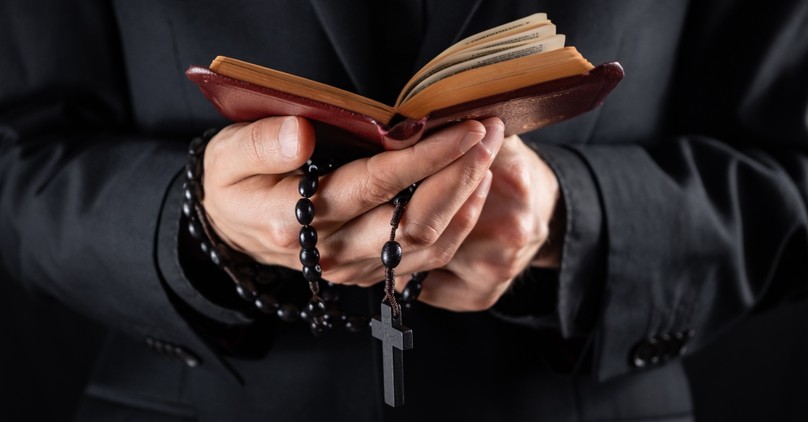
The history of Catholic rosary beads is an important part of Catholicism. According to Catholic tradition, the Catholic rosary beads were started by the Virgin Mary herself. In this article, we will take a deep dive into the history of the Catholic rosary beads.
Original Beginnings
As stated, according to Catholic tradition, the rosary beads were started by the Virgin Mary. In the traditional account found in Catholicism, the Virgin Mary appeared to St. Dominic in the 13th century, gave him a rosary, and instructed him to pray the "Hail Mary, Our Father and Glory" and teach all Christians how to pray the prayer. According to tradition, the Virgin Mary told St. Dominic to pray the "Hail Mary, Our Father and Glory" instead of praying the Psalms.
After receiving the rosary beads from the Virgin Mary, St. Dominic taught the rosary in his missionary work among the Albigensians. Some scholars are up in arms about the historicity of the account of how St. Dominic received the rosary beads from the Virgin Mary. What has been determined is that St. Dominic is connected with the genesis of the rosary beads.
As Christians, it's important that we dissect the word "hail." This verb means "to greet with great approval." Of course, Mary was the human mother of Jesus, but she was not divine. She did not have divine powers, and she cannot save any person from their sin—nor can she work as an intermediary between God and man. Jesus Christ is our only intermediary, and the Bible tells us that Jesus intercedes for us daily (Romans 8:34). Mary cannot pray on our behalf, nor can she speak to God for us. However, when we place emphasis on Mary, hailing her name before Christ's, we are neglecting the proper protocol to enter the Throne Room of Grace.
Hebrews 4:14-16 says, "Therefore, since we have a great high priest who has ascended into heaven, Jesus the Son of God, let us hold firmly to the faith we profess. For we do not have a high priest who is unable to empathize with our weaknesses, but we have one who has been tempted in every way, just as we are—yet he did not sin. Let us then approach God’s throne of grace with confidence, so that we may receive mercy and find grace to help us in our time of need."
Rising Popularity of the Rosary
The rising popularity of the rosary erupted during the 1500s when the Muslim Turks were causing havoc in Eastern Europe. Within the past fifty years, the Muslims had conquered Constantinople, which opened most of the Mediterranean at risk of being taken over by the Muslims. Due to the impending invasion coming upon them, Pope Pius V crafted a fleet under the direction and command of Don Juan of Austria. In the year 1571, Pope Pius V requested for all Catholics to pray the rosary and to ask for Mary’s help in the upcoming battle.
While the war battled on and Don Juan of Austria’s men were outnumbered, they were led to victory and defeated the Muslims at the Battle of Lepanto on October 7, 1571. Pope Pius V gave Mary credit for their victory against the Muslims, and he established a feast to commemorate the victory given them by Mary. The feast is now celebrated among Catholics on October 7, known as the Feast of the Holy Rosary. Even after several hundreds of years, Catholics are still faithful to celebrate this festival as a time to give praise to Mary and the victory they believe she gave them through praying the rosary.
Coming into the modern-day, the rosary beads remain extremely popular among Catholics. Catholics are the only belief system that uses the rosary. Meanwhile, it's important to note that the Bible never tells us that we have to use rosary beads to pray, nor are we told to pray the rosary. Thus, the tradition of the rosary beads is found within the Catholic denomination, and it is not found in the Holy Bible.
The Rosary Prayers
The beads on the rosary have the purpose of counting prayers. The rosary is supposed to help Catholics remember and recall specific events in history or “mysteries." Within the rosary, there are twenty mysteries reflected upon and remembered. These “mysteries” are divided into sections of five mysteries, which consist of five joyful mysteries, five luminous mysteries, five sorrowful mysteries, and five glorious mysteries.
The joyful mysteries are focused on Christ’s birth. The luminous mysteries were instituted by Pope John Paul II. The sorrowful mysteries are about Jesus’ suffering and His death, and lastly, the glorious mysteries are to remind individuals of Jesus’ resurrection from the dead and the glory of heaven. The other prayers prayed during the rosary are the "Apostle’s Creed," "Our Father," "Hail Mary," and "Glory Be."
Beads of the Rosary
There are a total of 59 beads in a single rosary. On the crucifix, one is to say the "Apostle’s Creed," on the following bead, one prays "Our Father," and then on the next three smaller beads, individuals pray three "Hail Marys." After these steps, one would pray "Glory Be" on the chain, then on the larger bead announce the mystery such as the joyful, luminous, sorrowful, or glorious mysteries and they say "Our Father." Once one has done this, on the following ten beads, Catholics are to pray ten "Hail Marys" while at the same time meditating on the mysteries. Lastly, Catholics pray "Glory Be" on the chain and then repeat it for the next forty years.
As one can see, this is a man-made aspect of religion. And while reciting "Glory Be" and "Our Father" reflects Scripture, we must realize that hailing Mary is found nowhere in Scripture. Elevating Mary to the same level as Father, Son, and Holy Spirit is idolatrous. In fact, in Scripture, the only command we read from Mary is found in John 2:5: "His mother said to the servants, 'Do whatever [Jesus] tells you.'" We are called by God and told by Mary to seek Christ Jesus in all aspects of life. He alone is worthy of praise, honor, and glory.
Catholic or not, the Gospel remains this simple yet powerful truth: Jesus died for your sins, was buried, and rose to life on the third day to provide salvation, redemption, and eternal life to all those who would place faith in Him (John 3:16-17). If a person believes in the Gospel, they are eternally saved. The rosary, penance, and other religious rituals are not necessary to achieve heaven. Maybe you have a special place you like to pray, or a certain Christian pendant you like to hold to make you feel connected to Christ as you pray, which is not sinful. However, prayers must be raised to Christ alone.
Why? Because Jesus died on the cross once and for all. He already suffered the pain and death we deserved for us to have eternal life with Him in Heaven, so your sole act for salvation is to confess your sins to Him and ask Him to be both Lord and Savior of your life.
If you accept Jesus as your Savior and Lord, you will have a direct relationship with God because Jesus is God. The Lord is always there for you and you don’t have to do any special rituals or practices in order for Him to hear you. He adores you for coming to faith in Him through Christ Jesus. No strings or rosary beads attached.
Photo Credit: ©Getty Images/Photoboyko









